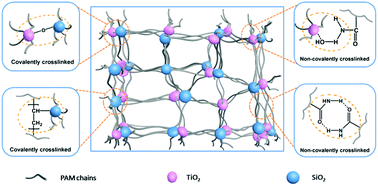Super-tough, anti-fatigue, self-healable, anti-fogging, and UV shielding hybrid hydrogel prepared via simultaneous dual in situ sol–gel technique and radical polymerization†
Abstract
In this work, we propose a universal strategy to construct tough hybrid hydrogels simply by a dual in situ sol–gel reaction of vinyltriethoxysilane (VTES) and tetrabutyl titanate (TBOT), as well as an in situ radical polymerization of acrylamide (AM) and VTES. Interestingly, nano-SiO2 and nano-TiO2 acted as both multifunctional hybrid crosslinker and nanofiller in this hybrid hydrogel. Meanwhile, covalent bonding existed between TiO2 and SiO2, as well as polymers and SiO2, and non-covalent interactions existed between TiO2 and polymers, as well as the organic skeleton. The obtained hybrid hydrogel exhibited high tensile strength (38.78–330.50 kPa), medium tensile elastic modulus (26.53–120.48 kPa), ultrahigh compression strength (1.86–6.22 MPa), unprecedented fatigue resistance, and self-healability due to its unique hierarchical inorganic hybrid crosslinking mechanism. In addition, this hydrogel also displayed considerable anti-fogging and UV-shielding property. Hence, this hybrid hydrogel will have many potential uses in soft robots, substitutes for load-bearing tissues, and optical devices.



 Please wait while we load your content...
Please wait while we load your content...